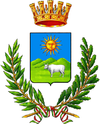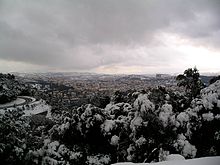- Nuoro
-
Nuoro
Nugoro— Comune — Comune di Nuoro View of Nuoro from the Supramonte of Oliena 
Coat of armsLocation of Nuoro in Italy Coordinates: 40°19′N 09°20′E / 40.317°N 9.333°ECoordinates: 40°19′N 09°20′E / 40.317°N 9.333°E Country Italy Region Sardinia Province Nuoro (NU) Frazioni Lollove Government – Mayor Alessandro Bianchi (PD) Area – Total 192.27 km2 (74.2 sq mi) Elevation 554 m (1,818 ft) Population (January 1, 2009) – Total 36,443 – Density 189.5/km2 (490.9/sq mi) Demonym Nuoresi Time zone CET (UTC+1) – Summer (DST) CEST (UTC+2) Postal code 08100 Dialing code 0784 Patron saint Santa Maria della Neve Saint day August 5 Website Official website Nuoro (Italian pronunciation: [ˈnu.oɾɔ] (
 listen), Sardinian: Nùgoro [ˈnuɡoɾɔ])[1] is a city and comune (municipality) in central-eastern Sardinia, Italy, situated on the slopes of the Monte Ortobene. It is the capital of the Province of Nuoro. With a population of 36,443 (est. 2009),[2] it is the fifth-largest city in Sardinia.
listen), Sardinian: Nùgoro [ˈnuɡoɾɔ])[1] is a city and comune (municipality) in central-eastern Sardinia, Italy, situated on the slopes of the Monte Ortobene. It is the capital of the Province of Nuoro. With a population of 36,443 (est. 2009),[2] it is the fifth-largest city in Sardinia.Birthplace of several renowned artists, including writers, poets, painters, and sculptors, Nuoro hosts some of the most important museums in Sardinia. It is considered the cultural capital of the region [3][4] and referred with the name of "Atene sarda" (Sardinian Athens).[5] Nuoro is the hometown of Grazia Deledda, the first and only Italian woman to win (1926) the Nobel Prize in Literature.
Contents
History
 View of Nuoro in winter from Monte Ortobene
View of Nuoro in winter from Monte Ortobene
The earliest traces of human settlement in the Nuoro area (called " the Nuorese") are the so-called Domus de janas, rock-cut tombs dated at the third millennium BC. However, fragments of ceramics of the Ozieri culture have also been discovered and dated at c. 3500 BC[citation needed]. The Nuorese was a centre of the Nuragic civilization (which developed in Sardinia from c. 1500 BC to c. 250 BC), as attested by more than 30 Nuragic sites, such has the village discovered in the countryside of Tanca Manna, just outside Nuoro, which was made of about 800 huts. The Nuorese was crossed by a Roman road which connected Karalis (Cagliari) to Ulbia (Olbia). The legacy of the Roman colonization can especially be found in the variety of the Sardinian language which is still spoken today in Nuoro: Sardu nugoresu is considered the most conservative language of the Romance family.
After the fall of the Western Roman Empire, Sardinia was held first by the Vandals and then by the Byzantines. According to the letters of Pope Gregory I, a Romanized and Christianized culture (that of the provinciales) co-existed with several Pagan cultures (those of the Gens Barbaricina, i.e. "Barbarian People") mainly located in the island's interior. As the Byzantine control waned, the Giudicati appeared. A small village known as Nugor appears on a medieval map from 1147. In the two following centuries it grew to more than 1000 inhabitants. Nuoro remained a town of average importance under the Aragonese and Spanish domination of Sardinia, until famine and plague struck it in the late 17th century. After the annexion to the Piedmont in the Kingdom of Sardinia, the town became the administrative center of the area, obtaining the title of city in 1836; in the 19th century it was one of the main cultural centers of Sardinia.
Demographic evolution

Museums
- Museo Archeologico Nazionale (National Archeological Museum).
- Museo Deleddiano (Grazia Deledda's Museum).
- Museo Etnografico Sardo (Sardinian Museum of Ethnography).
- M.A.N., Museo d’Arte Provincia di Nuoro (Modern Art Museum).
Transportation
Nuoro is served by the SS 131 DCN (Olbia-Abbasanta), the SS 129 (Orosei-Macomer), and the SS 389 (Monti-Lanusei). It is connected by train (FdS) to Macomer and by bus (ARST, Azienda Regionale Sarda Trasporti) to Cagliari, Sassari, Olbia, and to several minor centres in the province and the region. ATP Nuoro's bus system provides service within the city and nearby suburbs.
Notable people
- Antonio Ballero (1864–1932), writer, painter
- Francesco Ciusa (1883–1949), sculptor
- Giovanni Ciusa Romagna (1907–1958), painter
- Attilio Deffenu (1890–1918), trade unionist
- Grazia Deledda (1871–1936), writer
- Pasquale Dessanai (1868–1919), poet
- Marcello Fois (born 1960), writer
- Maria Giacobbe (born 1928), writer, essayist (publishes in Italian and Danish)
- Flavio Manzoni, car designer
- Franco Oppo (born 1935), composer
- Romano Ruiu (1935–1974), writer, poet, playwright
- Salvatore Satta (1902–1975), jurist, writer
- Sebastiano Satta (1867–1914), poet, lawyer
- Salvatore Sirigu (born 1987), footballer playing for PSG
Twin towns
References
- ^ Probably from a root meaning "home or hearth" in Logudorese.
- ^ Source: ISTAT
- ^ [1] Il mare letterario [please insert author of this paper](Italian)
- ^ [2] Cultural Notes by the Comune of Nuoro (Italian)
- ^ E. Corda, Atene Sarda. Storie di vita nuorese 1886-1946, Rusconi, 1992 - only available in Italian
- ^ "Twinning Ceremony". http://www.udine20.it/cerimonia-di-gemellaggio-tra-i-comuni-di-tolmezzo-e-nuoro. Retrieved 2010-04-01. (Italian)
External links
- Official Website (Italian)
- Official (Municipality) Tourism Website (Italian)
- Official (Region) Tourism Website (English)

Orani, Benetutti (Sassari) Benetutti (Sassari), Orune Orune, Dorgali 
Orani 
Oliena  Nuoro
Nuoro 

Orani Mamoiada, Orgosolo Orgosolo, Oliena Sardinia · Comuni of the Province of Nuoro Aritzo · Atzara · Austis · Belvì · Birori · Bitti · Bolotana · Borore · Bortigali · Desulo · Dorgali · Dualchi · Fonni · Gadoni · Galtellì · Gavoi · Irgoli · Lei · Loculi · Lodè · Lodine · Lula · Macomer · Mamoiada · Meana Sardo · Noragugume · Nuoro · Oliena · Ollolai · Olzai · Onanì · Onifai · Oniferi · Orani · Orgosolo · Orosei · Orotelli · Ortueri · Orune · Osidda · Ottana · Ovodda · Posada · Sarule · Silanus · Sindia · Siniscola · Sorgono · Teti · Tiana · Tonara · TorpèCategories:- Cities and towns in Sardinia
- Communes of the Province of Nuoro
- Nuoro
- Cities and towns in Italy
Wikimedia Foundation. 2010.



